Italian singular & plural nouns and adjectives
You may know that a noun identifies a person, place, thing, or idea.
A singular noun names one person, place, thing, or idea, while a plural noun names more than one person, place, thing, or idea.
It’s important to pay attention to whether the nouns we use are singular or plural and to know how to make nouns plural the right way.
This post takes a look at how Italian singular nouns and adjectives are turned into plural nouns and adjectives.
Check it out to learn about regular and irregular plurals as well as important definitions, rules, and exceptions.
How to make the plural form of nouns and adjectives
Mastering Italian grammar can be difficult. Here are the rules to form plural nouns and adjectives in Italian.
The main rule to make the singular of nouns and adjectives is as follows:
Nouns ending in –o, the ending changes to –i in the plural. See the example below:
- Singular: il libro
- Plural: i libri
Nouns ending in –a, the ending changes to –e in the plural.
- Singular: la bambina
- Plural: le bambine
Nouns ending in –ca change to –che in the plural.
- Singular: l’amica
- Plural: le amiche
Nouns ending in –e change to –i in the plural.
- Singular: lo studente
- Plural: gli studenti
The same applies to adjectives:
- bello, belli
- bella, belle
- grande, grandi
Practice with Quizlet
Here's a set of flashcards and quizzes to practice this grammar topic.Exceptions to the rule for nouns
There are several exceptions to the rules listed above:
For the nouns that end in –io, the –i is generally not repeated in the ending. Exceptions to this rule are words like lo zio, which becomes gli zii.
See the example below:
- il cavallo, i cavalli
- il tavolo, i tavoli
- il negozio, i negozi
There are certain feminine nouns ending in –a that change to –i in the plural.
See the example below:
- Singular: l’ala
- Plural: le ali
There are certain masculine nouns ending in –a that change ending to –i in the plural, along with nouns ending in –o and –e, which can be masculine or feminine.
See examples below:
- Singular: il problema
- Plural: i problemi
- Singular: la mano
- Plural: le mani
There are also nouns ending in –a that can be both masculine and feminine.
Dentista, for example, can be accompanied by the masculine or feminine article; la dentista or il dentista.
In these cases, the masculine noun changes to –i in the plural, and the feminine noun changes to –e in the plural.
See the example below:
- Masculine Plural: i dentisti
- Feminine Plural: le dentiste
Nouns that end in –ca and –ga have a hard sound that needs to be preserved in the plural. To do so, the plural forms add an –h, but are otherwise normal in their pluralization.
These nouns can be either feminine or masculine. Here is an example of each:
- Singular: la barca
- Plural: le barche
- Singular: il collega
- Plural: I colleghi
The same addition of the ‘h’ in the plural also applies to nouns ending in –go and in –co. Some nouns ending in –co, however, don’t include ‘h’ in the plural (l’amico à gli amici).
- Singular: il dialogo
- Plural:i dialoghi
- Singular: il pacco
- Plural: i pacchi
Lastly, another type of noun with a spelling change are those that end in –cia or –gia. If the –i in this ending is unstressed in the singular, it drops the –i in the plural.
However, if the –i is stressed, it is retained in the plural.
- Singular: la mancia
- Plural: le mance
- Singular: la farmacia
- Plural: le farmacie
In Italian grammar, other types of nouns are abbreviated, which are shortened to make them easier to write and say.
La foto, for example, is short for la fotografia.
With these nouns, they retain the same ending in the plural shortened forms (le foto).
Similarly, nouns that end with an accented vowel or a consonant don’t change in the plural, either.
See examples below:
- Singular: il caffé
- Plural: i caffé
- la città, le città
- la virtù, le virtù
- il papa, i papà
Nouns ending in consonants (which are often borrowed ‘foreign’ words) also have identical singular and plural forms.
Examples:
- il computer, i computer
- lo yogurt, gli yogurt
- il film, i film
All nouns ending in “-io” form the plural under the following rules.
If the “-i” is stressed, they form the plural in “-ìi”
Examples:
- Zio (uncle) – accent, zìo
- Rinvio (postponement) – accent, rinvìo
Change the ending in “-ii”
Examples:
- Zii
- Rinvii
If the “-i” is unstressed, they form the plural in “-i”
Examples:
- Cambio (change) – accent, càmbio
- Figlio (son) – accent, fìglio
Change the ending in “-i”
Examples:
- Cambi
- Figli
In Italian, there are also some nouns that in the plural change the root.
- L’uomo (the man), gli uomini;
- Il dio (god), gli dei;
- L’ala (wing), le ali;
- L’arma (weapon), le armi;
- Il tempio (temple), i templi / i tempi;
- Il bue (ox), i buoi;
- L’eco (feminine) (echo), gli echi (masculine)
A few masculine nouns ending in “-o” become feminine in the plural.
- Il paio (pair), le paia;
- L’uovo (egg), le uova;
- Il migliaio (thousand), le migliaia;
- Il riso (laugh), le risa;
- Il centinaio (hundred), le centinaia;
- Il miglio (mile), le miglia;










4 Responses
Bella, belli, shouldn’t it be bella, belle?
Ciao @meina! Yes, you’re right. The plural of bella is belle. Thank you for pointing it out 😊
Stefano,
Why is the adjective “bravo” before the noun ragazzo and not after?
It’s idiomatic. 🙂